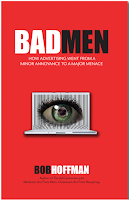Several months ago I wrote a guest post for Copyblogger called, "A Cranky, Skeptical Loudmouth Looks at Social Media Marketing." I re-read it the other day and liked it, so I thought I'd reproduce it here with a few edits. Also, it's Friday and I'm a lazy bastard.
I stand naked before you with the intent of committing heresy (okay, I’m not really naked, but I’m still pretty unsettling to look at.) My heresy is this – I don’t think the internet is all that interactive.
If I’m right, this has big ramifications for us in the marketing world.
Let’s start at the beginning.
What Do We Mean By Interactivity?
I know the web is interactive for you, and I know it’s interactive for me. But for the vast majority of internet users, the ones who don’t have blogs and don’t have their own websites, it is mostly another passive medium. And it’s getting passiver -- which is either a word I just made up or a new Jewish holiday.
Before you start hyperventilating, let’s define our terms. What do we mean by interactivity? I propose the following definition: the ability to interact with the content of the medium, not just the medium.
For example, television. You interact with the medium all the time. You change the channel. You turn the volume up and down. You lighten and darken the picture. But you don’t think of it as an interactive medium because you can’t interact with the content.
The web, on the other hand, allows you to post a comment about what an idiot I am, and it will appear on the screen almost instantaneously. So, rightly, you consider the internet more interactive than tv.
But how much more interactive? It is my contention that web interactivity is continuing to grow for most every function except marketing. It is my further contention that marketing on the web is evolving very much as marketing on tv evolved – people with stuff yelling at people with money.
The Electric Library Card
There are three major ways that marketing is manifest on the web: "search", "display", and "social marketing." The most popular use of the web for marketing has been search. Search is worrisome because it does not really fit our definition of interactivity.
Search is interactive in only the most mechanical sense. It is really just a very smart library index that allows us to access the stacks quickly and (sometimes) easily. We do not contribute to the content.
Two In A Thousand
Display is also worrisome. It’s hard to imagine a medium that could be more intrusive, wasteful, and inefficient than direct mail. But display is it.
The best figures I can find show that the response (click-through) rates on display ads are less than two in a thousand. This is ridiculously small. It is almost 10 times smaller than direct mail. And remember, with direct mail you have to tear off a post card, find a pen, fill out a card, walk to the mailbox and drop it in. With display ads, all you need to do is move your finger.
How can it be that display ads are so ineffective? Simple. We all trained our eyes to ignore banners ten years ago. Just like we trained our eyes to ignore small space newspaper ads.
When it became evident that display was a lousy response medium, those selling it to us changed their tune. Now they claim it’s a branding medium. To this I can only say – yeah, right.
Marketing To Ourselves
So the best hope for the web as a truly interactive marketing medium is "the conversation," i.e. social marketing. I am sure there are wonderful examples of marketers building valuable and profitable social networks. But please, don’t post comments with anecdotes about the wonderful social network this or that company has built. For every success you name, I can name a hundred failures. Let’s make that a thousand.
I don’t care what the conversation crowd says, the average consumer simply does not have the time or the inclination to have conversations with marketers. Most of them, wisely, don’t have conversations with their husbands. Why in the world would they want to have conversations with us?
You and I are web geeks. We spend way more time than we should looking at computer screens. We are not normal. Especially you. The biggest mistake any marketer can make is marketing to himself, i.e. assuming his customer is just like him. They’re not and they never will be.
The Age Old Problem
When it comes to marketing, the average person uses his computer much as he uses his television — in passive mode. He sits back and looks at what’s on the screen and when he’s tired of what’s on the screen he clicks to change the channel, uh, page.
Don’t kid yourself. As an online marketer, you are facing the same challenge that every marketer since the beginning of commerce has faced: How do you attract the attention of people who are actively trying to avoid you?
It would be lovely if the “social media/conversationalist” crowd were right and interactivity between marketer and marketee would evolve as a caring, loving relationship.
I’m officially skeptical.
Why The Economy Is In The Toilet:
Yesterday 27.4% of visitors to TAC spent over an hour here. I know this shit is fascinating but, people, there's work to be done!











